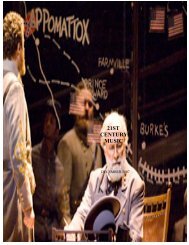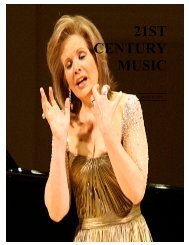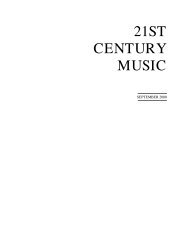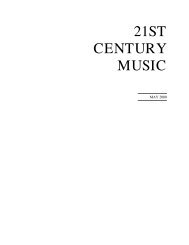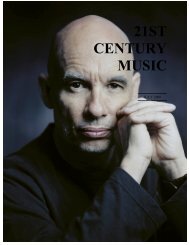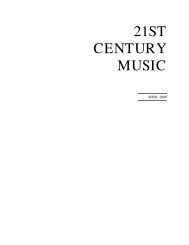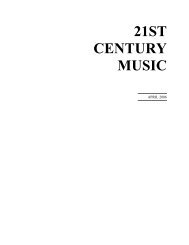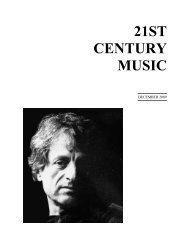Some months later, in December 1923, Chavez brieflyvisited the United States for the first time, returning inMarch 1924. During his time in New York, Chavezacquired a taste for the then-fashionable abstract andquasi-scientific music, as is reflected in the titles ofmany of his compositions then, including Polígonos forpiano (Polygons, 1923) and Exagonos for voice andpiano (Hexagons, 1924). At the same time, classicaltendencies of his early years re-asserted themselves insuch works as Sonatina for Violin and Piano (1924).He joined the staff of the newspaper El Universal in1924, writing 500 items over 36 years. Threads ofoverlapping influences continued, with a second Aztec /nationalist ballet, Los Cuatro Soles (The Four Suns,1925, and the compositions 36 for piano (1925) andEnergia for nine instruments (Energy, 1925).As public reception of his concerts continue to be onlylukewarm, Chavez decided to travel again to New Yorkin September 1926. Leaving behind his wife, daughter,and newborn son Agustín -- he ventured to America withMexican painter Rufino Tamayo, with whom he shared aflat in Greenwich Village. Chavez soon became friendswith both Aaron Copland and Edgar Varese, whoassisted him in becoming introduced to the musicalshakers of the time. His works began to be heard, andthey received favorable reviews.Having finally achieved his well-deserved acclaim,Chávez returned to Mexico in June of 1928 to accept thepost of musical director of the Orquesta SinfónicaMexicana. Reorganized under his leadership, theorchestra changed its name the following year to theOrquesta Sinfónica de Mexico and became the firststable orchestra in Mexico’s history, flourishing for 21seasons under Chavez’s directorship. He also wasappointed director of the Conservatorio Nacional wherehe taught composition and inspired a new generation ofMexican composers, among them Candelario Huizar,Silvestre Revueltas, Daniel Ayala, Blas Galindo,Salvador Contreras, and José Moncayo. Chavez wasinstrumental in taking the orchestra on tour throughMexico's rural areas.Also in 1928, Chavez was appointed director ofMexico's National Conservatory of <strong>Music</strong> -- a positionhe held for six years. In that capacity, the composerspearheaded projects to collect aboriginal folk music.At the same time, Chavez's scientific period came to itsculmination in the ballet H. P. (Horse Power, Caballosde Vapor, 1931, a colorfully orchestrated score of ampledimensions and dense, compact atmosphere, notable forits dynamism and vitality, revealing the influence ofStravinsky and at the same time returning to folkloricand popular elements, with dances such as the sandunga,tango, huapango, and foxtrot.Over the 1930's, Chávez returned to another of the mainmusical interests of his maturity, prefigured in thejuvenilia: the traditional genres of the sonata, quartet,symphony, and concerto.His six numbered symphonies begin with Symphony No.1 ("Sinfonía de Antígona", 1933), reworked fromincidental music for Jean Cocteau's Antigone, itself anadaptation of the Sophoclean tragedy. Here, Chávezseeks to create an archaic ambiance through the use ofmodal polyphony, quartal harmonies, and predominantwinds.Such concerns are also contained in Espiral for violinand piano (Spiral, 1934).At the same time, national tendencies continued in the1930's, notably in Chapultepec (1935) and SymphonyNo. 2 ("Sinfonía India") (1936, one of the few works byChavez to quote actual Native-American themes), andTen Preludes for Piano (1937).In 1937, he published a book, Toward a New <strong>Music</strong>,which is one of the first books in which a composerspeaks about electronic music. In 1938, Chavezcomposed the Concerto for Piano and Orchestra andconducted a series of concerts with the NBC SymphonyOrchestra, during Arturo Toscanini's absence.Chavez was commissioned in 1940 to compose a workto commemorate an exhibit of Mexican art New York’sMuseum of Modern Art, and the result was Xochipilli:An Imagined Aztec <strong>Music</strong>, scored for four winds and sixpercussionists, using a variety of indigenous Mexicaninstruments.In 1943, Chavez was inducted as one of 13 chartermembers of El Colegio Nacional and began lecturingextensively on musical subjects. He also beganEdiciones Mexicanas de <strong>Music</strong>a which helpedpopularize the music of many modern composers.By 1945, he had come to be regarded as the foremostMexican composer and conductor.2
Shortly after the inauguration of President MiguelAleman in 1946, Chavez was appointed director of anew administrative body called the Instituto Nacional deBellas Artes.From <strong>January</strong> 1947 until 1952, Chavez served asdirector-general of the National Institute of Fine Arts. Inhis first year, he formed the National SymphonyOrchestra.Due to his new responsibilities, however, Chávez had togive up his position with the Orquesta Sinfonía deMéxico, whose charter was dissolved in 1949, and hisoutput of new compositions was also significantlydiminished. Perhaps his most notable work from thisperiod was his Concerto for Violin and Piano (1950).Chávez retired from the Instituto Nacional de BellasArtes in 1952. During the 1950’s and 1960’s hereceived a number of commissions for new works,including three symphonies: Symphony No. 4(Louisville Symphony Orchestra), Symphony No. 5(Sergei Koussevitsky Foundation), and Symphony No. 6(Lincoln Center for the Performing Arts).In May 1953, he was commissioned by Lincoln Kirstein,director of the New York City center of <strong>Music</strong> andDrama, for a three-act opera to a libretto by ChesterKallman based on a story by Boccaccio, to be titled TheTuscan Players. Intended to be finished in August 1954,it was first postponed to April 1955, but only finallycompleted in 1956, by which time the title had beenchanged twice, first to Panfilo and Lauretta, then to ElAmor Propiciado. The City Center waived its rights tothe first performance, which was given under the titlePanfilo and Lauretta in the Brander Matthews Theatre atColumbia University in New York on May 9, 1957,under the baton of Howard Shanet. Stage direction wasby Bill Butler, scenic design by Herbert Senn and HelenPond, and costumes by Sylvia Wintle. The principalsingers were Sylvia Stahlman, Frank Porretta, CraigTimberlake, Mary McMurray, Michael Kermoyan, andThomas Stewart. The opera would be revised twice moreand the title changed again to Los Visitantes (TheVisitors), for productions in 1968 and 1973, in MexicoCity and Aptos, California, respectively.In the fourth lecture, Repetition in <strong>Music</strong> -- he describesa mode of composition already observable in many ofhis compositions since the 1920's, in which "the idea ofrepetition and variation can be replaced by the notion ofconstant rebirth, of true derivation: a stream that nevercomes back to its source; a stream in eternaldevelopment, like a spiral."He resumed administrative duties in 1969 when heaccepted the post as Secretariat of Public Education, andafter he had harshly criticized the current teachingmethods of the Conservatorio Nacional, Mexico’s newpresident Luis Echeverría appointed him to develop acomprehensive curriculum for the public schools andbestowed on him the post of Head of the <strong>Music</strong>Department of INBA and music director of the OrquestaSinfónica Nacional. A dispute with the orchestramembers’ union led to his resignation from both posts.His orchestral Discovery (1969) was commissioned bythe Cabrillo Festival of Contemporary <strong>Music</strong>. From thenext year to 1973, he served as the Festival's <strong>Music</strong>Director.Most of his final years were spent in New York City, ashe remained disillusioned with the state of musical lifein Mexico. He took an apartment directly across fromthe Lincoln Center in 1974, where he resided until hisdeath. He gave his final performance conducting thepremiere of his Concerto for Trombone on May8, 1978,in Washington, DC.Carlos Chavez died on August 2, 1978, while visitinghis daughter Ana in the Coyoacan suburb of MexicoCity.His manuscripts and papers are housed in the <strong>Music</strong>Division of the New York Public Library for thePerforming Arts and in the National Archive of Mexico,in Mexico City.From 1958-1959, he was the Charles Eliot Nortonprofessor at Harvard University, and the public lectureshe gave there were published as <strong>Music</strong>al Thought(1961).3



